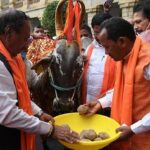 Moon Desk: These gentle herd animals are loved by many, but the disappearance of wild lands has led them into increasing conflicts with humans; they’re often killed when they wander onto roads (endangering human lives too) and they drive gardeners to distraction with their nibbling ways. They’re often targeted for mass kills to reduce their numbers, but these are ineffective and unnecessary. There are ways to peacefully coexist with deer.
Moon Desk: These gentle herd animals are loved by many, but the disappearance of wild lands has led them into increasing conflicts with humans; they’re often killed when they wander onto roads (endangering human lives too) and they drive gardeners to distraction with their nibbling ways. They’re often targeted for mass kills to reduce their numbers, but these are ineffective and unnecessary. There are ways to peacefully coexist with deer.
Deer have been forced to live close to us. They deserve our understanding. When deer come into conflicts with humans, communities often start talking about lethal means of control—but that shouldn’t be the answer. We have led advances in the field of immunocontraception, which provides an effective means of population control by preventing more births instead of killing the animals.
Morphology and behaviour: In all but one species of deer, males carry antlers; in the reindeer (Rangifer tarandus), both sexes carry antlers. The single antlerless form, the Chinese water deer (Hydropotes inermis), reflects an earlier pre-antler condition, as is shown by the fossil record. In this primitive condition males have long, sharp upper canines, called tusks, that are used for slashing and stabbing in territorial contests. Some species carry both antlers and tusks and show a progression of increased antler size and complexity with decreased size and functional structure of the tusks. (Musk deer resemble primitive deer in that males are armed with tusks.)
Deer have several other distinguishing characteristics. All deer lack the gall bladder. Females have four teats. Deer may have scent glands on their legs (metatarsal, tarsal, and pedal glands), but they do not have rectal, vulval, or preputal glands.
If you find a wild fawn, don’t assume they’ve been abandoned! Usually the mother is nearby grazing, making sure not to draw potential predators toward her little one. Unless you can see the fawn is injured or the mother is known to be dead, you don’t need to intervene.







